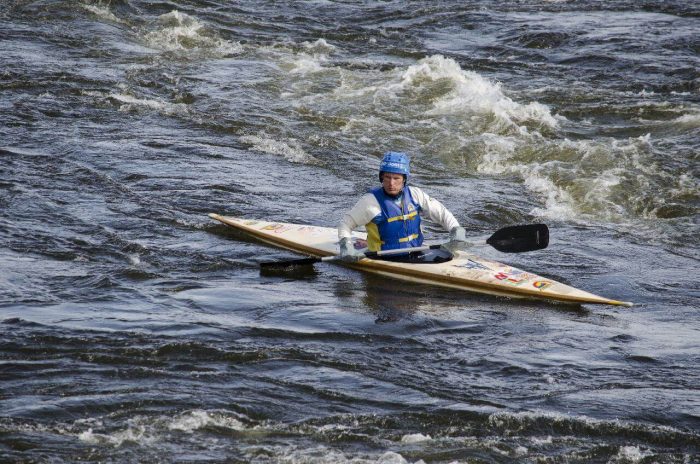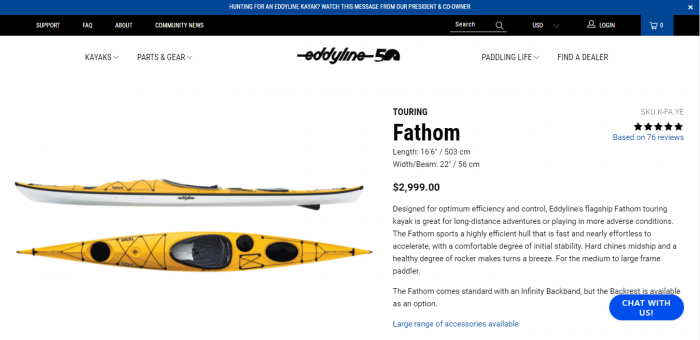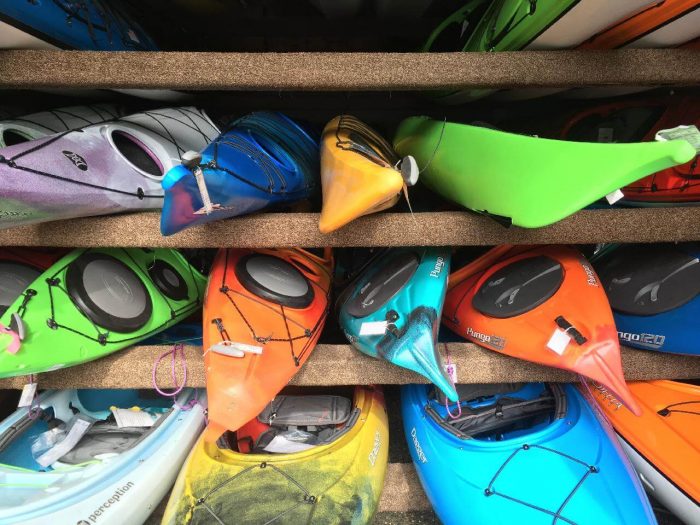Buying a kayak is not an easy job because there are quite a few things that you have to consider before buying a kayak. The first thing you have to decide is the purpose of the kayak and then choose the kayak type. You also have to consider the build materials, weight, seating, storage, paddle type, etc. before making the final decision.
Key Takeaways
- Recreational kayaks are versatile boats and they are perfect for casual use on bays and ponds
- Touring kayaks offer less storage space therefore they are not the best fishing kayak option
- Whitewater kayaks offer outstanding maneuverability and they deal with waves better
- If you love adventure then Downriver kayaks will be a great option for you because these types of kayaks travel quickly through the water
What Type Of Kayaking Will You Do?

There are plenty of kayak models available on the market. The destinations for the sport are what determine the kayak models. So, the first step in purchasing a kayak is to recognize your needs.
Here Are A Couple Of Questions To Ask For Starters:
1. Do you want a kayak for racing?
2. Or, one could be able to tackle rapids?
3. Or, one to begin touring for a week in the wilderness?
4. How often will you use the kayak?
5. How much are you willing to spend?
After you have carefully measured these and many other questions, the next step is to revise the differences among the numerous options.
Different Types Of Kayaks To Know Before Buying The Perfect One For You
Recreational Kayaks
Recreational kayaks are versatile boats designed for mild river trips. These kayaks are perfect for other casual use on bays and ponds. They are usually wider and shorter than touring kayaks. This distinctive feature comes with an advantage as kayakers find them easier to turn. And, the disadvantage is recreational kayaks make it more difficult to travel in a straight line.
Our Recommended Recreational Kayak: Ocean Kayak Frenzy Sit-On-Top Recreational Kayak
Touring Kayaks
Touring kayaks are often designed for extended wilderness trips and all the gear they involve. These long kayaks are favored for stability. Additionally, they have a good carrying capacity. Touring kayaks track well, as a result, they do not turn as easily as shorter boats.
They are sometimes referred to as sea kayaks, though they’re certainly not limited to the ocean. Some models are suitable for day touring. These kayaks offer less storage space. But, they make it up for less storage space with lighter weight and improved maneuverability.
Our Recommended Touring Kayak: Eddyline Fathom Kayak

Whitewater Kayaks
Whitewater kayaks offer outstanding maneuverability to tackle rapids. They tend to be shorter and can have rounded bottoms or flat planning hulls. And, whitewater kayaks deal with waves better. The rocker (upturn in the ends) is what allows them to deal with waves.
Whitewater kayak has its fair share of disadvantages. They are not enjoyable for touring, because kayakers become strained when paddling to keep it in a straight line.
Whitewater kayaks evolved a lot over the last five or six years, so we’ve discussed them in detail on this site. Make sure you check them out.
Our Recommended Whitewater Kayak: Dagger Mamba 8.6 Kayak
Downriver Kayaks
These are special boats designed for adrenaline junkies. Downriver kayaks travel quickly through the water. As a result, they are most often preferred for racing. These boats have a very long and narrow design.
The design makes these boats tippy. That is why experts of this site do not recommend these boats for novice paddlers. Their straight keel allows kayakers to track efficiently. But, it is difficult to turn with a downriver kayak.
What About the Kayak’s Dimensions?

Length
Longer kayaks come with plenty of advantages: kayakers enjoy easy paddling in longer kayaks. Longer kayaks are usually more stable. And, they are capable of transporting heavier loads with less loss of performance. They also track better. Besides easy maneuverability, these kayaks move faster and glide farther with each stroke than shorter boats. As a result, kayakers with long vessels enjoy greater efficiency with less effort.
Shorter kayaks, in contrast, are no doubt lighter. They are also comparatively less expensive (depending on material choice, of course). Kayakers find them less cumbersome, and easier to transport. But their most important asset is making quick turns. A short hull is also suitable for paddling on narrow streams. Smaller individuals and children favor these kayaks.
Width
The width of a kayak has a specific control on the boat’s managing characteristics. The main function of width is stability. However, handling is forgone for that additional width, and a slim kayak does not work fine in strong currents.
Extra width does add to a boat’s transport capacity (though not in so far as length), but kayaks that are really wide need a lot of attempt to paddle, because the hull has to drive aside a lot more water.
How Do Hulls Differ?
The common principles of kayak design are really very straightforward. Hulls with flat bottoms, hard chines (sharp, nearly right-angle edges where bottom and sides meet), and greater flare (curvature of the sides outward) have greater stability. Conversely, round hulls with soft chines (a slow curve where bottom and sides join) and less flare lead to less stability but are more lively and easier to turn over if they should tip over.
A lengthy, slim kayak with a bow-shaped resembling a narrow V will be fast because the bow cuts through the water rather than stacking in front of the boat. If instead you make a kayak that is wide in the beam and bring that fullness forward and backward, you have a freighter, not a racer. That kayak might be suitable for moving big loads and riding waves, but it will not be fast or very quick.
Symmetry
Kayaks are also symmetrical. Symmetry means that the front half and the back half of the kayak feature the same shape, or asymmetrical, which means that they don’t.
Symmetry is a factor to consider when you are determining the efficiency of the boat as it moves through the water. Symmetry also affects its ability to turn. Symmetrical boats are suitable for maneuvering quickly, as in tackling small streams or whitewater.
Asymmetrical boat designs usually extend and reorganize the bow for a more competent and faster channel through the water. Directional control is improved, however turning ability is decreased.
There are two kinds of asymmetrical shapes: fish form and Swede form. Fish form boats gain more volume fore (ahead) of the midpoint, conversely, Swede form has more volume aft (behind) of the midpoint.
Rocker
The expansion of the kayak’s hull from one point to the other (when viewed from the side of the kayak) is called a rocker. Kayaks with a lot of rocker turn by far, because their ends assemble higher in the water and present less resistance to waves. However, they do not track well.
On the other hand, kayaks with little rocker tracks are much better comparatively. It is because they oppose the rotating forces of waves, current, wind, and inept paddling strokes. Consequently, they do not turn as effortlessly when the paddler uses a proper turning stroke or lean.
The rockered bow, obvious on whitewater kayak stalwart Jared Seiler’s boat on the Patagonia Triple Crown expedition.
Bottom Shapes
The bottom of a kayak (when viewed from its ends) varies from flat to V-shaped. Flat-bottomed kayaks appear very stable at first. Rounded hulls are at first less stable than flat bottoms. But, in the end, they offer greater secondary stability when the boat is tilted.
The more distinct the V-shape on the bottom, the superior the boat’s directional control. But, this decreases its initial stability. Flat planning hulls are general on whitewater boats, while touring-kayak designers favor more rounded bottoms.
Chines
The change between the base of the kayak and its sides has recognized the chine. An unexpected, nearly right-angle change is called a hard chine, and a smoother, more curved one is a soft chine.
Flare is defined as the slant of a kayak’s sides outer from the hull. Kayaks with flared sides offer better stability but are more difficult to turn over.
Bottom Line
Buying a kayak requires research effort – whether you want to buy a brand new kayak or a used one. This buyer’s guide will introduce you to every critical aspect regarding kayaks – from water type to Chinese kayaks. After going through this guide, you will feel confident in buying the perfect kayak for yourself.
References:
- https://protips.dickssportinggoods.com/sports-and-activities/water-sports/how-to-buy-a-kayak
- https://www.rei.com/learn/expert-advice/kayak.html
- https://www.anacondastores.com/water-sports/kayaks/kayaks-buying-guide

Rockey is a kayaking enthusiast who has been kayaking with a local group for the last five years. He loves using kayaks while out on outings on the water or camping when the friends want to have a BBQ party somewhere on the bank of a local lake. More About James R Rockey at About Page Here: Authors
Based on his experiences with the different types of kayaks, he is sharing his opinion about kayaking tricks and required gears so that a beginner can get started right away.
Find his team on Twitter here. Happy reading!
